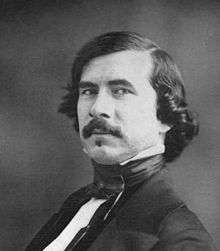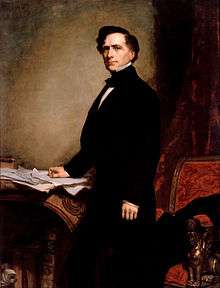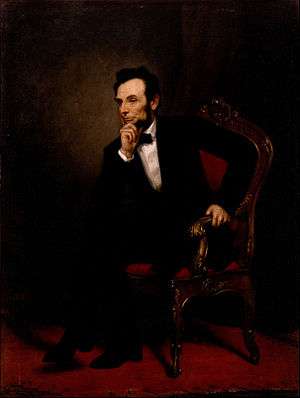George Peter Alexander Healy
| George Peter Alexander Healy | |
|---|---|
 A photograph of Healy by Southworth & Hawes | |
| Born |
July 15, 1813 Boston, Massachusetts, U.S. |
| Died |
June 24, 1894 (aged 80) Chicago, Illinois, U.S. |
| Nationality | American |
| Known for | Painting |
| Notable work |
The Peacemakers Abraham Lincoln |
George Peter Alexander Healy (July 15, 1813 – June 24, 1894) was an American portrait painter. He was one of the most prolific and popular painters of his day, and his sitters included many of the eminent personages of his time.
Biography
He was born in Boston, Massachusetts. He was the eldest of five children of an Irish captain in the merchant marine. Having been left fatherless at a young age, Healy helped to support his mother. When sixteen years of age he began drawing, and at once fired with the ambition to be an artist. Jane Stuart, daughter of Gilbert Stuart, aided him in every way, loaned him a Guido's "Ecce Homo", which he copied in color and sold to a country priest. Later, she introduced him to Thomas Sully, by whose advice Healy profited much, and gratefully repaid Sully in the days of the latter's adversity. At eighteen, Healy began painting portraits, and was soon very successful. In 1834, he went to Europe, leaving his mother well provided for, and remained abroad sixteen years during which he studied with Antoine-Jean Gros in Paris and in Rome, came under the pervading influence of Couture, and painted assiduously.[1] He received a third-class medal in the Paris Salon of 1840. In 1843 he was elected into the National Academy of Design as an Honorary Academician. He won a second-class medal in Paris in 1855, when he exhibited his "Franklin urging the claims of the American Colonies before Louis XVI."[2]

This year, also, saw him in Chicago, Illinois, where he remained until 1869, when he again visited the Continent, painting steadily, chiefly in Rome and Paris, for twenty-one years. In 1892, he returned to Chicago, where he died on June 24, 1894.[2]
Healy's autobiography, Reminiscences of a Portrait Painter, was published in 1894.[1]
Works

Healy was one of the most prolific and popular painters of his day. He was remarkably facile, enterprising, courageous, and industrious. "All my days are spent in my painting room" (Reminiscences). His style, essentially French, was sound, his color fine, his drawing correct and his management of light and shade excellent. His likenesses, firm in outline, solidly painted, and with later glazings, are emphatic, rugged, and forceful.
Among his portraits of eminent persons are those of Daniel Webster, Henry Clay, John Calhoun, Pius IX (1871), Arnold Henry Guyot, William H. Seward, Louis Philippe, Marshal Soult, Hawthorne, Prescott, Longfellow, Liszt, Gambetta, Thiers, Lord Lyons, Sallie Ward and the Princess (later the queen) of Romania. He painted portraits of all the presidents of the United States from John Quincy Adams to Ulysses Grant—this series being painted for the Corcoran Gallery, Washington, D.C.[2][1] Healy also painted The Peacemakers in 1868 and Abraham Lincoln in 1869. In one large historical work, Webster's Reply to Hayne (1851; in Faneuil Hall, Boston), there are one hundred and thirty portraits.
His principal works include portraits of Lincoln (Corcoran Gallery), Bishop (later Cardinal) McClosky (bishop's residence, Albany), Guizot (1841, in Smithsonian Institution), Audubon (1838, Boston Soc. Nat. Hist.), Comte de Paris (Met. Mus. Of Art, New York), Isaac Thomas Hecker C.S.P., Founder of the Paulist Fathers (North American Paulist Center, Washington, D.C.)
Healy's 1877 portrait of a young Lincoln was the model used for a Lincoln postage stamp, issued on February 12, 1959, the 150th anniversary of Lincoln's birth.
Gallery
 Portrait of Jim Bowie, c. 1820
Portrait of Jim Bowie, c. 1820 Portrait of Millard Fillmore, 1857
Portrait of Millard Fillmore, 1857 Portrait of John Quincy Adams, 1858
Portrait of John Quincy Adams, 1858 Portrait of Martin Van Buren, 1858
Portrait of Martin Van Buren, 1858 Portrait of James K. Polk, 1858
Portrait of James K. Polk, 1858 Portrait of Franklin Pierce, 1858
Portrait of Franklin Pierce, 1858 Portrait of James Buchanan, 1859
Portrait of James Buchanan, 1859 Portrait of Sallie Ward, 1860
Portrait of Sallie Ward, 1860 Orestes A. Brownson, 1863
Orestes A. Brownson, 1863 Portrait of John Tyler, 1864
Portrait of John Tyler, 1864 Portrait of William Tecumseh Sherman, 1866
Portrait of William Tecumseh Sherman, 1866
 The Peacemakers, 1868
The Peacemakers, 1868 Abraham Lincoln, 1869
Abraham Lincoln, 1869 Pope Pius IX, 1871
Pope Pius IX, 1871 Portrait of Carol I of Romania, 1873
Portrait of Carol I of Romania, 1873 Self-Portrait, 1886
Self-Portrait, 1886
References
- Attribution
 Chisholm, Hugh, ed. (1911). "Healy, George Peter Alexander". Encyclopædia Britannica (11th ed.). Cambridge University Press.
Chisholm, Hugh, ed. (1911). "Healy, George Peter Alexander". Encyclopædia Britannica (11th ed.). Cambridge University Press. This article incorporates text from a publication now in the public domain: Hunt, Leigh Harrison (1913). "George Peter Alexander Healy". In Herbermann, Charles. Catholic Encyclopedia. New York: Robert Appleton.
This article incorporates text from a publication now in the public domain: Hunt, Leigh Harrison (1913). "George Peter Alexander Healy". In Herbermann, Charles. Catholic Encyclopedia. New York: Robert Appleton.
External links
| Wikimedia Commons has media related to George Peter Alexander Healy. |
- Works by or about George Peter Alexander Healy in libraries (WorldCat catalog)
 This article incorporates text from a publication now in the public domain: Chisholm, Hugh, ed. (1911). "article name needed". Encyclopædia Britannica (11th ed.). Cambridge University Press.
This article incorporates text from a publication now in the public domain: Chisholm, Hugh, ed. (1911). "article name needed". Encyclopædia Britannica (11th ed.). Cambridge University Press.